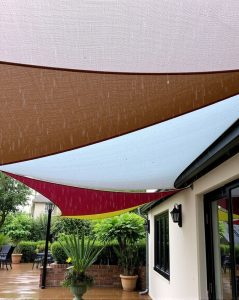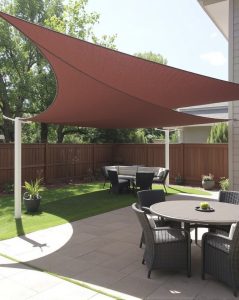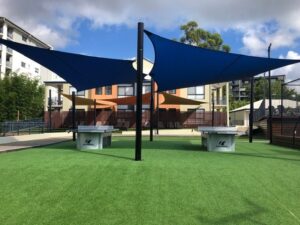
Shade Sails: Protection from Rain and Hail
Rain is beautiful—until it’s not. While we often appreciate the soothing sound of raindrops or the fresh scent that follows a storm, it’s easy to

Shade netting is an essential tool in crop management, offering numerous advantages that can enhance crop quality and yield. Its primary function is to regulate sunlight exposure, protecting plants from excessive heat and sunburn, particularly during hot summer periods. This protective barrier also reduces water evaporation from the soil, maintaining optimal moisture levels, which is especially beneficial in arid climates or during droughts.
In addition to light and moisture regulation, shade netting provides protection against harsh weather conditions such as strong winds, heavy rain, and hail. By creating a physical barrier between crops and environmental elements, it minimizes damage and reduces the risk of crop loss, ensuring more consistent yields. Shade netting also contributes to the creation of a stable microclimate, reducing temperature fluctuations and fostering a more favorable growth environment.
The multifaceted benefits of shade netting make it an invaluable asset for growers seeking to optimize crop production. Its ability to mitigate environmental stressors and create ideal growing conditions contributes significantly to improved agricultural outcomes.
When selecting shade netting for your crop, one of the most important considerations is the level of shading provided, typically expressed as a percentage. Different crops have different light level requirements, so it’s essential to choose a shade netting with the appropriate level of shading for your specific crop. For instance, crops that thrive in full sun, such as tomatoes and peppers, may only require a light shading of around 30-40%, while more delicate crops, like lettuce and spinach, may benefit from a higher level of shading, around 50-70%.
In addition to shading levels, the durability and lifespan of the shade netting are crucial factors to consider. Look for shade netting made from high-quality materials, such as UV-stabilized polyethylene, which can withstand prolonged exposure to sunlight without degrading.
Furthermore, consider the size and structure of the netting, ensuring it is suitable for the size and layout of your growing area. Additionally, take into account any extra features that may be beneficial for your specific crop, such as anti-aphid properties or insect-repelling additives. By carefully considering these factors, you can ensure that you choose the right shade netting to maximize the benefits for your crop.
Proper installation of shade netting is crucial for ensuring its maximum effectiveness in protecting and promoting the growth of your crops. Before installing the shade netting, it’s important to prepare the area by clearing any debris and ensuring that the soil is well-prepared for planting. Once the area is ready, begin by securing the shade netting over the growing area using suitable support structures, such as poles or wire frames.
Ensure that the netting is taut and securely fastened to prevent it from sagging or coming loose in strong winds. When installing shade netting, it’s important to consider the orientation and positioning of the netting to ensure that it provides optimal shading for your crops. In general, shade netting should be positioned to provide protection from the hottest midday sun, while still allowing sufficient light for plant growth.
Additionally, consider the airflow and ventilation around the shaded area to prevent heat buildup and promote healthy plant growth. Finally, regularly inspect and maintain the shade netting to ensure that it remains in good condition and continues to provide effective protection for your crops. By following these installation guidelines, you can maximize the effectiveness of shade netting in creating a favorable growing environment for your crops.
| Metrics | Value |
|---|---|
| Temperature Reduction | Up to 10°C |
| Humidity Control | Up to 80% |
| Shade Netting Material | HDPE (High-Density Polyethylene) |
| UV Protection | Up to 90% |
Shade netting plays a crucial role in managing temperature and humidity levels within a growing area, creating a more stable and favorable environment for plant growth. By providing a shaded environment, shade netting helps to reduce the intensity of sunlight and heat that reaches your crops, preventing excessive temperature fluctuations and heat stress. This can be particularly beneficial during hot summer months when high temperatures can be detrimental to plant health and productivity.
Additionally, shade netting can help to reduce water evaporation from the soil, maintaining optimal moisture levels and preventing dehydration of your plants. In addition to managing temperature, shade netting also helps to regulate humidity levels within the growing area. By providing a shaded environment with reduced direct sunlight exposure, shade netting can help to prevent excessive moisture loss from plant leaves and soil.
This can be especially beneficial in arid climates or during periods of low humidity when plants are more susceptible to drying out. Furthermore, by reducing direct sunlight exposure, shade netting can help to minimize the risk of fungal diseases that thrive in warm and humid conditions. Overall, by effectively managing temperature and humidity levels, shade netting plays a vital role in creating an optimal growing environment for your crops.
Shade netting provides an effective barrier against pests and diseases, helping to protect your crops from common threats that can significantly impact their health and productivity. By creating a physical barrier between your plants and external pests, such as insects and birds, shade netting helps to prevent damage caused by feeding and nesting activities. This can be particularly beneficial for vulnerable crops or during periods when pest pressure is high.
Additionally, shade netting can also help to reduce the spread of airborne diseases by preventing contact between infected plants and healthy ones. Furthermore, shade netting can also help to create a more controlled growing environment that is less favorable for pest and disease development. By reducing direct sunlight exposure and regulating temperature and humidity levels, shade netting can help to minimize conditions that are conducive to pest infestations and disease outbreaks.
This can be especially beneficial for crops that are susceptible to specific pests or diseases prevalent in your region. By providing an effective barrier against pests and diseases and creating a less favorable environment for their development, shade netting plays a crucial role in protecting the health and productivity of your crops.
Regularly monitor the condition of the shade netting to ensure it remains in good condition and continues to provide effective protection for your crops. Inspect for any signs of damage or wear, such as tears or sagging, and promptly repair or replace any compromised areas to maintain the integrity of the shading barrier.
In addition to monitoring the physical condition of the shade netting, it’s also important to assess its effectiveness in providing optimal shading for your crops. Regularly evaluate the light levels within the shaded area to ensure they remain within the desired range for your specific crop. Consider using light meters or simply observing plant growth patterns to gauge whether adjustments are needed to achieve optimal shading levels.
Furthermore, consider making seasonal adjustments to the shade netting to accommodate changing light conditions throughout the year. For example, during cooler months or when plants require more sunlight for flowering or fruiting, you may need to temporarily reduce shading levels by adjusting or removing sections of the shade netting. Conversely, during hot summer months or when plants are at risk of sunburn, you may need to increase shading levels by adding additional layers or using denser shade netting.
By regularly monitoring and adjusting shade netting as needed, you can ensure it continues to provide optimal protection and support for your crops throughout their growth cycle.
After successfully growing your crops with the help of shade netting, it’s time to reap the rewards by harvesting and evaluating your yield. When harvesting under shade netting, take care to gently remove plants from their supports or trellises without damaging them or causing unnecessary stress. Handle harvested produce carefully to avoid bruising or other damage that could reduce its quality or shelf life.
Once you have harvested your crops, take time to evaluate their yield and quality compared to previous seasons or similar crops grown without shade netting. Consider factors such as overall yield quantity, size and appearance of produce, and any noticeable improvements in flavor or texture. Additionally, assess whether shade netting helped protect your crops from common issues such as sunburn or pest damage.
In addition to evaluating yield quantity and quality, consider any cost savings or efficiency improvements achieved through using shade netting. For example, did reduced water evaporation under shade netting lead to lower irrigation costs? Did protection from pests and diseases result in fewer losses or reduced need for chemical treatments?
By carefully evaluating these factors, you can determine whether using shade netting was a worthwhile investment for your crop production. In conclusion, shade netting offers numerous benefits for crop management by providing protection from harsh weather conditions, regulating temperature and humidity levels, and creating a more controlled environment that is less favorable for pests and diseases.
By carefully selecting and installing shade netting tailored to your specific crop needs, monitoring its effectiveness throughout the growing season, and evaluating its impact on yield and quality at harvest time, you can maximize its benefits for your crop production efforts.
Check out this article here to find out more about Shade Netting!

Rain is beautiful—until it’s not. While we often appreciate the soothing sound of raindrops or the fresh scent that follows a storm, it’s easy to

Outdoor spaces are evolving, and shade sails are leading the charge. Picture this: a well-designed, UV-protected patio that stays cool under the summer sun, all

South Africa’s weather is as diverse as its landscapes. From the arid plains of the Northern Cape to the lush, subtropical coastlines of KwaZulu-Natal, the

As the days grow longer and the sun shines brighter, it’s time to start thinking about how you can make the most of your outdoor

Duranet provides a 12-year Fabric & Material warranty. Only the finest, high strength fabrics that are both durable and flexible are used. All our manufacturers have been specifically selected for their quality 12-year warranty.
Duranet solutions protect vehicles and property from the natural and harsh elements that are caused by the weather such as the sun, frost, rain and hail.
